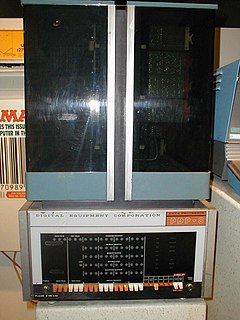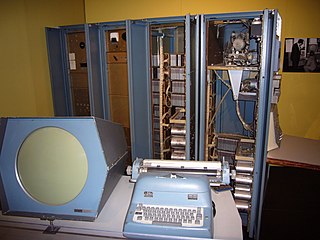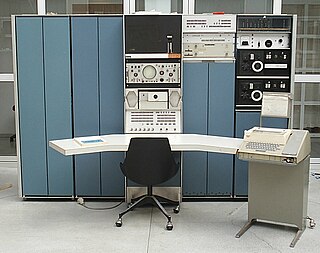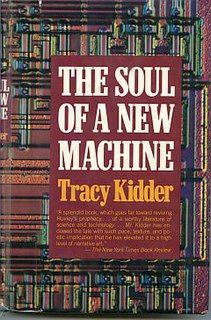
Digital Equipment Corporation, using the trademark Digital, was a major American company in the computer industry from the 1960s to the 1990s. The company was co-founded by Ken Olsen and Harlan Anderson in 1957. Olsen was president until forced to resign in 1992, after the company had gone into precipitous decline.

A minicomputer, or colloquially mini, is a class of smaller general purpose computers that developed in the mid-1960s and sold for much less than mainframe and mid-size computers from IBM and its direct competitors. In a 1970 survey, The New York Times suggested a consensus definition of a minicomputer as a machine costing less than US$25,000, with an input-output device such as a teleprinter and at least four thousand words of memory, that is capable of running programs in a higher level language, such as Fortran or BASIC.

Programmed Data Processor (PDP), referred to by some customers, media and authors as "Programmable Data Processor," is a term used by the Digital Equipment Corporation from 1957 to 1990 for several lines of minicomputers.

The PDP-1 is the first computer in Digital Equipment Corporation's PDP series and was first produced in 1959. It is famous for being the computer most important in the creation of hacker culture at Massachusetts Institute of Technology, BBN and elsewhere. The PDP-1 is the original hardware for playing history's first game on a minicomputer, Steve Russell's Spacewar!

The PDP-11 is a series of 16-bit minicomputers sold by Digital Equipment Corporation (DEC) from 1970 into the 1990s, one of a set of products in the Programmed Data Processor (PDP) series. In total, around 600,000 PDP-11s of all models were sold, making it one of DEC's most successful product lines. The PDP-11 is considered by some experts to be the most popular minicomputer.

The PDP-7 was a minicomputer produced by Digital Equipment Corporation as part of the PDP series. Introduced in 1964, shipped since 1965, it was the first to use their Flip-Chip technology. With a cost of US$72,000, it was cheap but powerful by the standards of the time. The PDP-7 is the third of Digital's 18-bit machines, with essentially the same instruction set architecture as the PDP-4 and the PDP-9.

Data General was one of the first minicomputer firms of the late 1960s. Three of the four founders were former employees of Digital Equipment Corporation (DEC).

A superminicomputer, colloquially supermini, was a high-end minicomputer. The term was used to distinguish the emerging 32-bit architecture midrange computers introduced in the mid to late 1970s from the classical 16-bit systems that preceded them. The development of these computers was driven by the need of applications to address larger memory. The term midicomputer had been used earlier to refer to these systems. Virtual memory was often an additional criteria that was considered for inclusion in this class of system. The computational speed of these machines was significantly greater than the 16-bit minicomputers and approached the performance of small mainframe computers. The name has at times been described as a "frivolous" term created by "marketeers" that lacks a specific definition. Describing a class of system has historically been seen as problematic: "In the computer kingdom, taxonomic classification of equipment is more of a black art than a science." There is some disagreement about which systems should be included in this class. The origin of the name is uncertain.

The history of computing hardware starting at 1960 is marked by the conversion from vacuum tube to solid-state devices such as transistors and then integrated circuit (IC) chips. Around 1953 to 1959, discrete transistors started being considered sufficiently reliable and economical that they made further vacuum tube computers uncompetitive. Metal-oxide-semiconductor (MOS) large-scale integration (LSI) technology subsequently led to the development of semiconductor memory in the mid-to-late 1960s and then the microprocessor in the early 1970s. This led to primary computer memory moving away from magnetic-core memory devices to solid-state static and dynamic semiconductor memory, which greatly reduced the cost, size, and power consumption of computers. These advances led to the miniaturized personal computer (PC) in the 1970s, starting with home computers and desktop computers, followed by laptops and then mobile computers over the next several decades.

Chester Gordon Bell is an American electrical engineer and manager. An early employee of Digital Equipment Corporation (DEC) 1960–1966, Bell designed several of their PDP machines and later became Vice President of Engineering 1972–1983, overseeing the development of the VAX. Bell's later career includes entrepreneur, investor, founding Assistant Director of NSF's Computing and Information Science and Engineering Directorate 1986–1987, and researcher emeritus at Microsoft Research, 1995–2015.
Kenneth Harry "Ken" Olsen was an American engineer who co-founded Digital Equipment Corporation (DEC) in 1957 with colleague Harlan Anderson and his brother Stan Olsen.

The Soul of a New Machine is a non-fiction book written by Tracy Kidder and published in 1981. It chronicles the experiences of a computer engineering team racing to design a next-generation computer at a blistering pace under tremendous pressure. The machine was launched in 1980 as the Data General Eclipse MV/8000.
The PDP-5 was Digital Equipment Corporation's first 12-bit computer, introduced in 1963.

The Professional 325 (PRO-325), Professional 350 (PRO-350), and Professional 380 (PRO-380) were PDP-11 compatible microcomputers introduced in 1982 by Digital Equipment Corporation (DEC) as high-end competitors to the IBM PC.

David H. Ahl is an American author who is the founder of Creative Computing magazine. He is also the author of many how-to books, including BASIC Computer Games, the first computer book to sell more than a million copies.
In computer architecture, 12-bit integers, memory addresses, or other data units are those that are 12 bits wide. Also, 12-bit central processing unit (CPU) and arithmetic logic unit (ALU) architectures are those that are based on registers, address buses, or data buses of that size.
In computer architecture, 18-bit integers, memory addresses, or other data units are those that are 18 bits wide. Also, 18-bit central processing unit (CPU) and arithmetic logic unit (ALU) architectures are those that are based on registers, address buses, or data buses of that size.
Mainframe computers are computers used primarily by businesses and academic institutions for large-scale processes. Before personal computers, first termed microcomputers, became widely available to the general public in the 1970s, the computing industry was composed of mainframe computers and the relatively smaller and cheaper minicomputer variant. During the mid to late 1960s, many early video games were programmed on these computers. Developed prior to the rise of the commercial video game industry in the early 1970s, these early mainframe games were generally written by students or employees at large corporations in a machine or assembly language that could only be understood by the specific machine or computer type they were developed on. While many of these games were lost as older computers were discontinued, some of them were ported to high-level computer languages like BASIC, had expanded versions later released for personal computers, or were recreated for bulletin board systems years later, thus influencing future games and developers.
Digital Equipment Corporation (DEC), was a major American company in the computer industry. Founded in 1957 with $70,000 of venture capital, it became "the nation's second-largest computer company, after IBM." Its initial major impact was in minicomputers, but its later-introduced VAX and Alpha systems are still notable.
BASIC-8, is a BASIC programming language for the Digital Equipment (DEC) PDP-8 series minicomputers. It was the first BASIC dialect released by the company, and its success led DEC to produce new BASICs for its future machines, notably BASIC-PLUS for the PDP-11 series. DEC's adoption of BASIC cemented the use of the language as the standard educational and utility programming language of its era, which combined with its small system requirements, made BASIC the major language during the launch of microcomputers in the mid-1970s.













